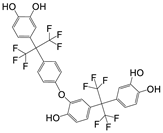Abstract
In catalytic tests, the results have shown that almost all the BPAF was removed within 30 min when the dosage of Co3O4@BiOI and sodium persulfate (PS) was 0.15 g and 0.1 mM, respectively. Acid conditions inhibited BPAF degradation, but the inclusion of a precise concentration of bicarbonate ions (HCO3−) promoted degradation. The presence of chloride (Cl−), sulfate ions (SO42−), and a high concentration of HCO3− inhibited the degradation process, whereas the addition of nitrate ions (NO3−) had a minor effect on the catalytic process. The presence of free radicals (sulfate (SO4•−), hydroxyl (•OH), and superoxide (O2•−)) and the non-free radical singlet oxygen (1O2) in the Co3O4@BiOI/PS system was determined by electron paramagnetic resonance (EPR) and quenching tests. We propose that the Co(II)/Co(III) and Bi(III)/Bi(V) redox pairs simultaneously activate PS where the Co3O4 and BiOI components work synergistically to promote the rapid oxidative degradation of BPAF in water.
1. Introduction
Bisphenol A (BPA) is widely used in the synthesis of plastics and resins. However, BPA has been identified as an endocrine-disrupting chemical (EDC), which can severely impair the nervous, immune, and reproductive systems of organisms even at low doses [1]. As the use of BPA has been restricted in several countries, a number of chemicals with similar structures, such as bisphenol AF (BPAF), have been developed as replacements [2,3]. As a result of the large-scale production and widespread application in various industries, concentrations of BPAF up to 15.3 μg/L have been detected in rivers, groundwater, sewage, and landfill site leachate [4]. Reports have shown that BPAF exhibits a reproductive toxicity and endocrine-disrupting effect equivalent to or even greater than BPA [5]. Moreover, BPAF has a longer half-life and poorer biodegradability [6]. Various methods have been developed to treat BPAF in wastewater, including montmorillonite-mediated photodegradation [7], ferrate oxidation [8], periodate activation [9], catalytic peroxymonosulfate (PMS) oxidation [10], and chlorination [11]. These methods exhibit a number of shortcomings, such as high cost, complicated operation, and secondary pollution, which hinder practical application [12,13,14]. Consequently, an efficient BPAF treatment and removal method is urgently required.
The application of advanced oxidation processes based on sulfate radicals (SO4•−) in the degradation of pollutants in water samples is emerging as an effective treatment [15]. There are a number of methods for activating persulfate, including thermal activation [16], ultrasonic activation [17], photoactivation [18], transition metal activation [19], and synergistic activation techniques [20]. Transition metal activation has emerged as a promising oxidation technology that does not require additional energy, operating under mild reaction conditions to deliver high reaction rates [21,22]. The transition metal ions (Fe2+, Cu2+, Mn2+, and Co2+) activate PS by cleaving the O-O bond via electron transfer [23] (Equations (1) and (2)). Co2+ has been confirmed superior to other transition metal ions in activating PMS/PS, but the discharge of toxic Co2+ in homogeneous catalytic systems presents serious environmental issues. To overcome the problem of ion dissolution, research has shifted to consider the use of cobalt-based heterogeneous catalysts [24].
S2O82− + Men+→Me(n+1)+ + SO42− + SO4•−
SO4•− + Men+→Me(n+1)+ + SO42−
Attention has now turned to tricobalt tetroxide (Co3O4) due to the low associated cobalt dissolution and high catalytic activity, though catalytic performance is usually attenuated by particle agglomeration [25]. Increasing contact of free radicals with pollutants is key to improving the efficiency of PS activation by heterogeneous catalysts [26]. Chen et al. prepared BC-Co3O4 to activate PMS for antibiotic degradation by loading Co3O4 on rice straw-derived biochar. The results have shown that the use of biochar introduces porosity and facilitates the transfer of Oxone to the Co3O4 active sites with the subsequent generation of free radicals [27]. Su et al. synthesized Co3O4/polyurushiol 3D-graphene and Co3O4/polyurushiol–graphene/polyurethane foam composite materials with hierarchical porous structures using a simple solvothermal method to catalyze PMS for the degradation of antibiotics. The results have shown that the antibiotic rate can reach 97.8% in only 0.5 min [28].
In this study, a Co3O4@BiOI composite material with a petal structure has been prepared using a simple hydrothermal synthesis strategy. The application of Co3O4@BiOI combined with PS to remove refractory organics (BPAF) in water is explored for the first time. The morphology, crystal form, components, surface element valence, and chemical bond energy have been analyzed using an array of characterization techniques. The latter includes scanning electron microscopy (SEM), transmission electron microscopy (TEM), X-ray diffraction (XRD), and Fourier-transform infrared spectroscopy (FT-IR). In addition, X-ray photoelectron spectroscopy (XPS), electron paramagnetic resonance (EPR), and quenching tests were conducted to explore the reaction mechanism associated with the Co3O4@BiOI/PS system. This work extends the current understanding of BPAF degradation in SO4•−-based advanced oxidation processes.
2. Materials and Methods
2.1. Chemicals and Reagents
Bisphenol AF (C15H10F6O2), bismuth nitrate pentahydrate (Bi(NO3)3∙5H2O), persulfate (PS) were purchased from Sigma-Aldrich (Shanghai, China). Tricobalt tetraoxide (Co3O4) and potassium iodide (KI) were purchased from Kelong Chemical (Chengdu, China).
2.2. Preparation of Co3O4@BiOI
Different ratios of Co3O4@BiOI samples were prepared by a hydrothermal method. The appropriate mass ratios of Bi(NO3)3∙5H2O and Co3O4 were dissolved in 30 mL absolute ethanol and stirred at 300 rpm for 30 min to obtain solution A. KI (0.4980 g) was dissolved into 30 mL deionized water to obtain solution B. Solution B was slowly added into stirring solution A. The mixed solution was ultrasonicated for 30 min, then the mixed solution was transferred into a stainless 100 mL Teflon-lined autoclave, sealed, and kept at 180 °C for 24 h. The as-prepared samples were washed with deionized water and absolute ethanol several times and then dried at 80 °C in an oven for 24 h.
2.3. Catalyst Characterization
An Ultima IV diffractometer (Rigaku, Tokyo, Japan) was employed to analyze the crystal structure of the material, using Cu Kα radiation (λ = 1.54184 Å), an operating voltage of 40 kV, operating current of 40 mA. Particle structure and morphology, surface composition, and crystal lattice spacing were determined using a JSM-7500F field emission-SEM (JEOL, Tokyo, Japan) and a high-resolution transmission electron microscope (FEI Talos F200x, Waltham, MA, USA). The electron paramagnetic resonance (EPR) spectra were obtained on a spectrometer (Brucker EMX-PLUS, Karlsruhe, Germany). Surface functional groups were analyzed by Fourier-transform infrared (FT-IR) spectroscopy (Spectrum 1000, PerkinElmer, Waltham, WA, USA).
3. Results and Discussion
3.1. Characteristic of Co3O4@BiOI
The phase and crystallographic structure of the materials were determined by XRD. The XRD patterns of the synthesized Co3O4@BiOI nanomaterial are shown in Figure 1. All diffraction peaks from the Co3O4@BiOI catalyst were in good accordance with the result of JCPDS No.42-1467. The peaks at 2θ = 19.00°, 31.27°, 36.85°, 59.35°, and 65.23° correspond to the (111), (220), (311), (511), and (440) planes, respectively. The XRD pattern of pure BiOI corresponds to the tetragonal structure and the peaks matched very well with the standard diffraction pattern (JCPDS No.10-0445). The peaks at 2θ = 9.66°, 29.65°, 31.66°, 45.38°, 46.48°, 55.15°, 66.12°, and 75.13° indexed to the (001), (102), (110), (200), (201), (221), (220), and (310) planes of BiOI microspheres.
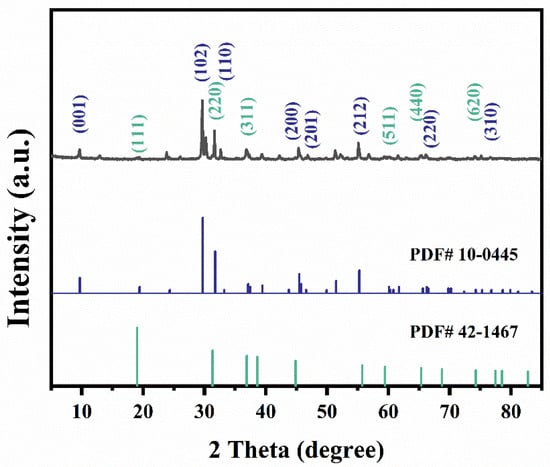
Figure 1.
XRD of as-synthesized Co3O4@BiOI.
Figure 2a–c illustrate the morphologies and crystal structures of the prepared Co3O4@BiOI. As shown in Figure 2a, the BiOI [29] nanosheets exhibit a petal-shaped distribution with rod-shaped Co3O4 particles attached to the nanosheet surface. Further insights into the interior structure of Co3O4@BiOI nanocomposites were obtained by transmission electron microscopy (TEM). Figure 2d–f show the typical TEM image of the Co3O4@BiOI nanocomposites, which has revealed an orderly arrangement of atoms or groups of atoms associated with the material. Application of the Fourier-transform algorithm has identified two crystal lattice spacings in the composite material, where the spacing (0.16 nm) for Co3O4 is consistent with the reported findings [30,31]. However, the crystal lattice spacing for BiOI (0.36 nm) is higher than the value (0.28 nm) given in the literature [32,33], suggesting that the Co3O4 and BiOI particles are closely linked together at the nanometer level.
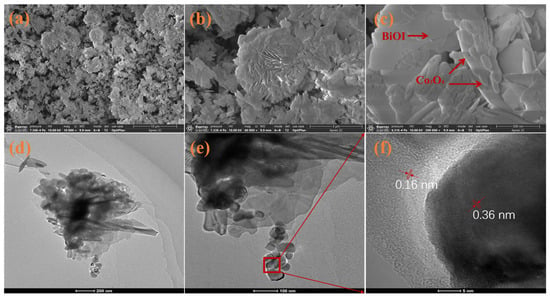
Figure 2.
SEM (a–c) and TEM (d–f) images of as-synthesized Co3O4@BiOI.
Characterization of the Co3O4@BiOI composite by FTIR generated the spectra presented in Figure 3. Characteristic absorption peaks at 5,671,375 and 1626 cm−1 are observed in BiOI [34]. In addition, peaks at 662 and 579 cm−1 are attributed to Co-O bond stretching in the Co2+-coordinated tetrahedron and the Co-O bond in the Co3+-coordinated octahedron, respectively [35].
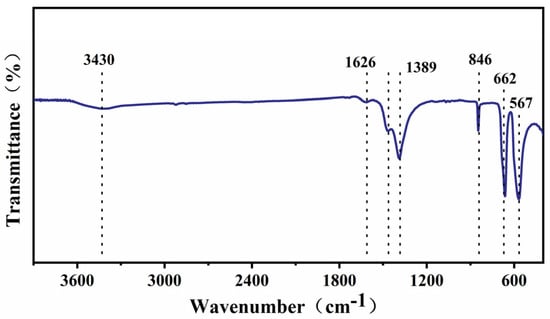
Figure 3.
FT−IR spectra of as−synthesized Co3O4@BiOI.
3.2. Evaluation of Catalytic Efficiency
3.2.1. Effect of Doping
The effect of different levels of Co3O4 doping (0.1% Co3O4@BiOI, 0.5% Co3O4@BiOI, 5% Co3O4@BiOI, 10% Co3O4@BiOI, 20% Co3O4@BiOI, and 50% Co3O4@BiOI) on the catalytic activity was assessed. As shown in Figure 4, Co3O4 doping had a significant influence on the BPAF removal rate, with the highest activity delivered by 50% Co3O4@BiOI, where the BPAF in water was almost completely removed within 30 min. The 50% Co3O4@BiOI composite was accordingly selected for subsequent testing.
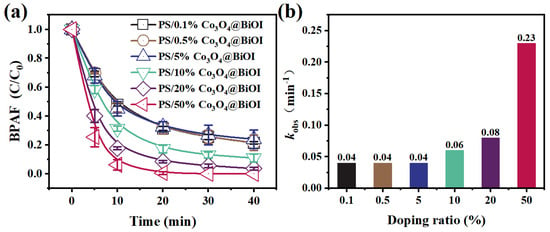
Figure 4.
Comparison of the Co3O4@BiOI/PS system. (a) Effect of different Co doping on the degradation; (b) kinetics.
3.2.2. Comparison Experiment
In this study, blank control systems (PS, BiOI/PS, Co3O4/PS, Co3O4@BiOI, and Co3O4@BiOI/PS) were employed to assess the catalytic performance of Co3O4@BiOI. As shown in Figure 5, minor changes were observed in the BPAF removal rate from the aqueous solution with the addition of PS or Co3O4@BiOI alone. The removal rate by Co3O4@BiOI/PS was markedly higher than that recorded for BiOI/PS (26.4%) and Co3O4/PS (9.3%) under the same conditions. The results have established that the Co3O4@BiOI composite prepared by adding Co3O4-modified BiOI exhibited significantly higher activity than pure BiOI or Co3O4 before modification.

Figure 5.
(a) A controlled experiment of different systems; (b) control experiment under light/without light system.
Furthermore, the catalytic performance was evaluated using extra light/without extra light control systems (extra light only, extra light/PS, extra light/Co3O4@BiOI, extra light/Co3O4@BiOI/PS, and without extra light Co3O4@BiOI/PS). There was no apparent effect on BPAF removal under the extra light only, extra light/PS, and extra light/Co3O4@BiOI conditions. In comparing extra light/Co3O4@BiOI/PS with without extra light Co3O4@BiOI/PS, the BPAF degradation rate by the extra light/Co3O4@BiOI/PS system was slightly higher than without extra light Co3O4@BiOI/PS in the first 10 min of the reaction, but both systems converged with a near-complete degradation of BPAF within 30 min. The reaction system without extra light could save the energy required for light irradiation processing and had greater economic advantages, so the subsequent experiments were conducted under conditions without extra light.
3.2.3. Effect of PS Concentration
The effects of the PS dosage on the BPAF removal rate by Co3O4@BiOI/PS have been examined. As shown in Figure 6, the degradation rate was 1.7% in the absence of PS, indicating negligible catalytic activity or BPAF adsorption on the composite. Increasing the PS dosage from 0.05 mM to 0.1 mM resulted in an increase in the BPAF degradation rate from 86.9% to 95.2%, and the kobs value was raised from 0.050 min−1 to 0.075 min−1. The degradation was largely invariant with a PS dosage increase to 0.2 mM, 0.4 mM, and 0.8 mM generating values of 95.3%, 96.5%, and 96.7%, with associated kobs of 0.077 min−1, 0.082 min−1, and 0.083 min−1, respectively, demonstrating a stable BPAF oxidation rate. In further tests, the PS dosage was fixed at 0.1 mM.
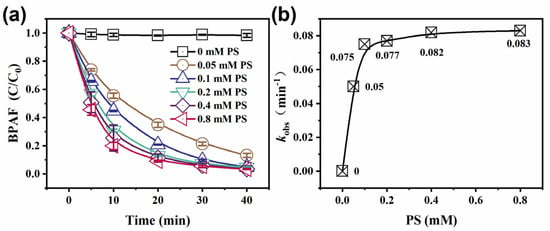
Figure 6.
Effect of PS dosage on BPAF removal in the Co3O4@BiOI/PS system. (a) BPAF removal; (b) kobs of BPAF.
3.2.4. Effect of Initial pH
The influence of the initial pH on the degradation of BPAF by Co3O4@BiOI/PS is shown in Figure 7. The removal rate was lowest at pH 3.0 with higher values as the pH was increased to 5.0, 9.0, and pH 11.0. The degradation rate and kobs remained at low levels in neutral or acid solution. Under strongly acidic (pH 3.0) conditions, the system produces more protons that consume the •O2− generated. The acid conditions can inhibit the production of other reactive groups, limiting the degradation of BPAF [36]. At an initial pH of 9.0, the BPAF degradation rate was 70.6%, lower than that (95.2%) at an initial pH of 7.85. An increase in the initial pH to 11.0 resulted in the near-complete degradation of BPAF (99.5%), with a kobs of 0.126 min−1. The increase in OH− under strongly alkaline conditions results in an increased •OH concentration in the system, enhancing the degradation rate of BPAF. The results demonstrate that Co3O4@BiOI/PS is sensitive to the initial solution pH and works more effectively in strongly alkaline environments.
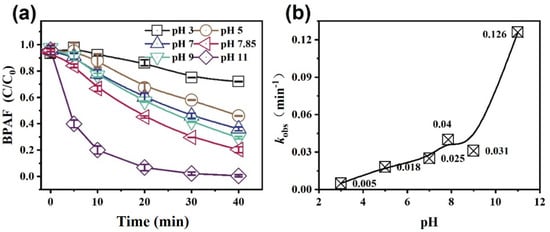
Figure 7.
Effect of the solution pH on BPAF removal in the Co3O4@BiOI/PS system. (a) BPAF removal; (b) kobs of BPAF (experimental conditions: [Co3O4@BiOI]0 = 150 mg/L, [PS]0 = 0.1 mM, [BPAF]0 = 5 mg/L, initial pH = 3.0~11.0, T = 25 ± 1 °C, reaction time: 40 min).
3.2.5. Effect of Inorganic Anions
The effects of common inorganic anions (bicarbonate (HCO3−), chloride (Cl−), sulfate (SO42−), and nitrate (NO3−) ions) in water on the degradation of BPAF by Co3O4@BiOI/PS have been examined as an important consideration in terms of practical application.
As shown in Figure 8a, the degradation rate exhibited a two-way trend of increasing and decreasing values in the case of the HCO3− concentration in the solution. The degradation rate was 100%, 95.0%, and 47.6% at 10 mM, 50 mM, and 100 mM HCO3−, respectively. This suggests an optimum concentration of HCO3− in terms of BPAF oxidative degradation where the reaction system is suppressed at high concentrations. Relevant studies have revealed that a low concentration of HCO3− can serve to quench SO4•− and •OH, producing the bicarbonate radical (HCO3•−) with low associated activity in the oxidative degradation of organic pollutants, resulting in a lower BPAF conversion [37,38].
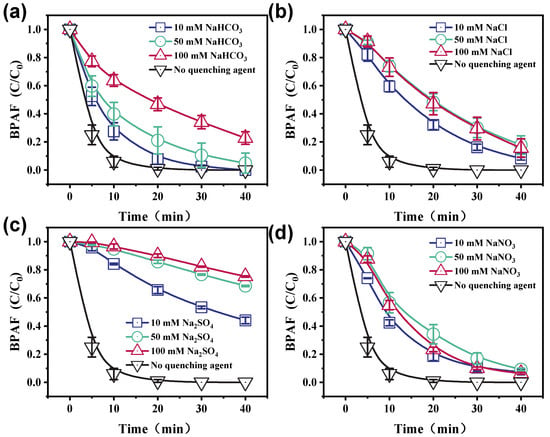
Figure 8.
Effects of anions at different concentrations on BPAF removal in the Co3O4@BiOI/PS system. (a) HCO3−, (b) Cl−, (c) SO42−, (d) NO3−. (Experimental conditions: [Co3O4@BiOI]0 = 150 mg/L, [PS]0 = 0.1 mM, [BPAF]0 = 5 mg/L, initial pH = 3.0~11.0, T = 25 ± 1 °C, reaction time: 40 min).
The results presented in Figure 8b,c show the dependence of BPAF degradation on the Cl− and SO42− concentrations, which served to inhibit the reactivity of Co3O4@BiOI/PS. As can be seen in Figure 8b, the BPAF degradation rate was lowered from 100% to 91.8%, 84.4%, and 82.2%, respectively, following the addition of 10 mM, 50 mM, and 100 mM Cl− to the solution under the controlled experimental conditions. The Cl− in the system can react with SO4•− to generate Cl• and Cl2•− with low oxidation capability, impeding BPAF degradation [39]. Moreover, the degradation rate of BPAF dropped to 56.0%, 31.5%, and 24.7%, respectively, after adding 10 mM, 50 mM, and 100 mM SO42− (Figure 8c), demonstrating inhibition by SO42− that was more pronounced at higher concentrations.
The inclusion of varying NO3− concentrations had a minor effect on BPAF degradation (Figure 8d), resulting in a slight increase from 92.7% to 90.8% and 93.6% at 10 mM, 50 mM, and 100 mM NO3−, respectively.
3.3. Reusability of Co3O4@BiOI
Continuous and intermittent cyclic recycling experiments were conducted to assess the stability and reusability of the Co3O4@BiOI composite. The experimental results shown in Figure 9 reveal that after two continuous cyclic degradation experiments, BPAF removal was still close to 100%, demonstrating catalyst stability. The cyclic BPAF degradation was continued with catalyst recycles, and the level of degradation declined from 91% to 84% and 81% over the third to fifth recycle. The intermediates produced during oxidative degradation in repeated reactions can poison the catalyst and lower the activity. When compared with similar catalytic materials, the Co3O4@BiOI composite exhibited good stability. Dissolution of Co2+ was established where the concentration of cobalt ions in the solution (0.07 mg/L) at the end of the reaction. The results demonstrate that the Co3O4@BiOI catalyst has good reusability and a low metal dissolution rate with no serious environmental pollution impact, suggesting viable practical application.
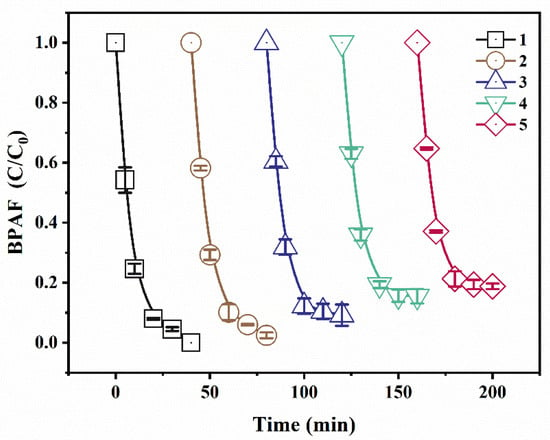
Figure 9.
Recycling test on the Co3O4@BiOI/PS system.
Figure 10 graphically represents the XRD results before and after the reaction. Assessment of Figure 10 reveals that the Co3O4@BiOI composite’s XRD peaks, following the reaction, vanished at 2θ values of 9.66°, 55.15°, 75.13°, 31.27°, 59.35°, and 64.10° when juxtaposed with its pre-reaction state. The lattice planes of BiOI at (001), (212), and (310) correspond with the XRD peaks at 2θ of 9.66°, 55.15°, and 75.13° whilst the Co3O4 lattice planes at (220), (511), and (620) consistently align with the XRD peaks at 2θ of 31.27°, 59.35°, and 64.10°. This strengthens the argument that the Co3O4 and BiOI constituents in the Co3O4@BiOI composite are participants in the oxidation process.

Figure 10.
XRD patterns of the synthesized Co3O4@BiOI before and after reaction. (Experimental conditions: initial [Co3O4@BiOI]0 = 150 mg/L, [PS]0 = 0.1 mM, [BPAF]0 = 5 mg/L, initial pH = 7.85 ± 0.2, T = 25 ± 1 °C).
Figure 11 demonstrates a negligible modification in the FT-IR spectra of the Co3O4@BiOI composite before and after the reaction, indicating the high stability of the Co3O4@BiOI chemical bonds.
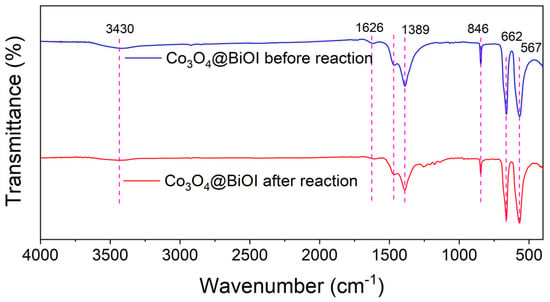
Figure 11.
FT−IR patterns of the synthesized Co3O4@BiOI before and after reaction. (Experimental conditions: initial [Co3O4@BiOI]0 = 150 mg/L, [PS]0 = 0.1 mM, [BPAF]0 = 5 mg/L, initial pH = 7.85 ± 0.2, T = 25 ± 1 °C).
3.4. PS Activation Mechanism of Co3O4@BiOI
3.4.1. Identification of Active Species
Methanol (MeOH), tert-butyl alcohol (TBA), L-histidine, and p-benzoquinone (BQ) can act as quenchers of SO4•−, •OH, O2•−, and 1O2, respectively, and were used to identify the major active species produced in the PS oxidation reaction system. As shown in Figure 12a,b, the removal rate of BPAF fell from 95.8% to 53.2%, 21.1%, and 14.4%, respectively, after adding 10 mM, 50 mM, and 100 mM MeOH to the Co3O4@BiOI/PS system. This response indicates that both SO4•− and •OH may play a crucial role in the oxidative degradation of BPAF. The removal rate of BPAF was decreased to 93.2%, 45.8%, and 10%, respectively, with the addition of increasing concentrations (10 mM, 50 mM, and 100 mM) of TBA. The inhibition caused by 100 mM TBA was equivalent to that recorded for 100 mM MeOH, suggesting that •OH plays a leading role in the reaction system. The inhibition due to a low concentration of TBA was less than that observed with MeOH, suggesting the crucial role of •OH in degradation though SO4•− and •OH are produced simultaneously in the reaction system. The removal rate of BPAF decreased to 87.3%, 21.6%, and 12.2%, respectively, after adding 1 mM, 5 mM, and 10 mM L-histidine (Figure 12c), suggesting the possible presence of 1O2 in the Co3O4@BiOI/PS system. Moreover, the removal rate of BPAF only dropped to 93.4%, 88.6%, and 75.7% after adding 0.1 mM, 0.5 mM, and 1 mM BQ, suggesting the possible presence of •O2− in the Co3O4@BiOI/PS system but its contribution to the oxidative degradation of BPAF is relatively weak.
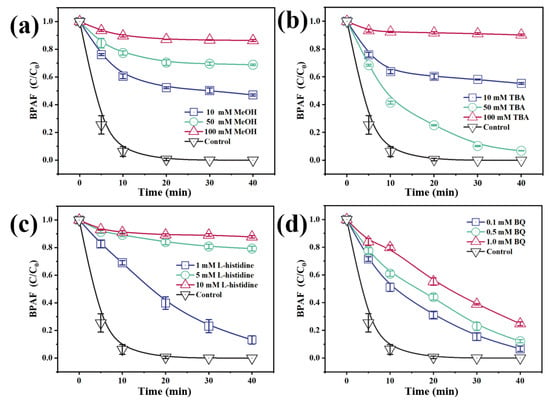
Figure 12.
Quenching tests for different reactive oxygen species ([Co3O4@BiOI]0 = 150 mg/L, [PS]0 = 0.1 mM, [BPAF]0 = 5 mg/L, initial pH = 7.85 ± 0.2, T = 25 ± 1 °C). (a) MeOH; (b) TBA; (c) L-histidine; (d) BQ.
The results of the quenching tests using the chemical probe method have revealed that four active species (SO4•−, •OH, •O2−, and 1O2) may be formed in the Co3O4@BiOI/PS system. We have employed EPR spectroscopy to further determine the free and non-free radicals found in the system. In the tests, 5,5-dimethyl-1-pyrroline N-oxide (DMPO) served as a free radical scavenger for SO4•−, •OH, and •O2−, and 2,2,6,6-tetramethylpiperidine-1-oxyl (TEMP) was used as a non-free radical scavenger for 1O2. As shown in Figure 13a, a clear signal with four split lines at an intensity ratio of 1:2:2:1 for the DMPO-OH adduct and a relatively weak signal with six split lines at an intensity ratio of 1:1:1:1:1:1 for the DMPO-SO4 adduct were observed at 3 min after adding DMPO to the system. The signal for the DMPO-SO4 adduct was weaker than the DMPO-OH adduct. This is attributed to the rapid conversion of SO4•− produced in the reaction system to •OH or conversion of the DMPO-SO4 adduct into DMPO-OH adduct. The signals for DMPO-SO4 and DMPO-OH adducts were gradually enhanced over the reaction time, consistent with the continuous production and gradual increase in SO4•− and •OH in the system over the first 15 min of the reaction.

Figure 13.
The detection results of (a) SO4•−, •OH, (b) •O2−, and (c) 1O2 by EPR technology.
A significant quadruple-peak signal (DMPO-O2) with an intensity ratio of 1:1:1:1 (Figure 13b) was detected by EPR at 3 min after adding DMPO to the system, which is attributed to •O2−. The intensity of the DMPO-O2 signal gradually increased as the reaction proceeded. The results indicate that •O2− is present in the reaction system and increases over the first 15 min of the reaction, which differs from the results of the quenching tests. This may suggest that O2•− mainly serves as an intermediate in the activation of PS by Co3O4@BiOI and is not directly involved in the oxidative degradation of BPAF.
As shown in Figure 13c, a clear triple-peak signal (TEMP-1O2) with an intensity ratio of 1:1:1 was detected by EPR at 3 min after adding TEMP to the system, proving the presence of 1O2 in the system. The TEMP-1O2 signal intensity increased over the first 15 min of the reaction, indicating an increased production of 1O2 in the system.
In summary, the results confirm the co-existence of free radicals (SO4•−, •OH, and O2•−) and non-free radicals (1O2) in the Co3O4@BiOI/PS system, which act to synergistically promote the degradation of BPAF in water. The O2•− radical mainly acts as an intermediate to facilitate catalytic oxidation during the activation of PS by Co3O4@BiOI.
3.4.2. Catalysis Mechanism
The chemical states and composition of Co3O4@BiOI were characterized by XPS. The XPS survey spectra revealed no variations in the major element species associated with Co3O4@BiOI before and after the reaction, identifying Bi, I, Co, O, and C as the major components. The peaks at 163.6 eV and 158.3 eV in the high-resolution XPS spectra are shown in Figure 14.
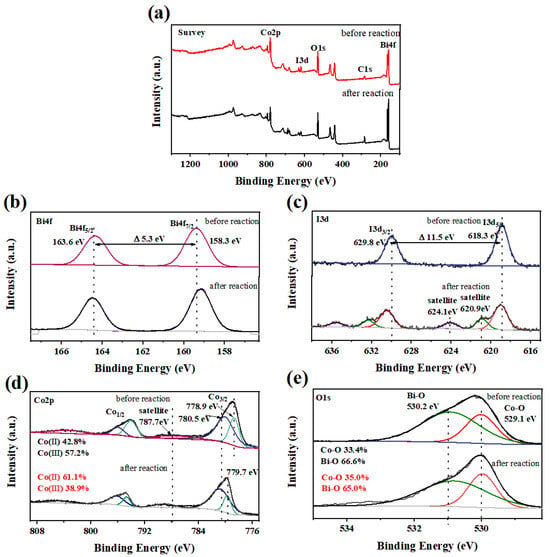
Figure 14.
XPS spectra of the synthesized Co3O4@BiOI. (a) Survey spectra; (b) Bi 4f; (c) I 3d; (d) Co 2p; (e) O 1s.
Possible changes to the surface chemistry of Co3O4@BiOI in activating PS were assessed by XPS analysis of the composite before and after the reaction (Figure 14). The XPS survey spectra revealed no variations in the major element species associated with Co3O4@BiOI before and after the reaction, identifying Bi, I, Co, O, and C as the major components. As shown in Figure 14b,c, there is no evident alteration in the spectra of Bi 4f and I 3d following the reaction. The XPS analysis has not detected a conversion between Bi(Ⅲ) and Bi(V) during the reaction. In contrast, the spectra of Co 2p before and after BPAF degradation establish a difference in the Co(II) and Co(III) composition (Figure 14d). The atomic composition of Co(II) and Co(III) was changed from 61.1% and 38.9% to 42.8% and 57.3% after the reaction. This response may be attributed to electron donation by Co(II), increasing the Co(III) content as part of the Co(II)-Co(III)-Co(II) cycle during the catalytic reaction [40]. The results suggest the interactive conversion of Co(II) to Co(III) in the Co3O4@BiOI that promotes PS activation. The spectra of O1s before and after the reaction are presented in Figure 14e and show an increase in the relative contribution of Co-O from 33.4% to 35.0% following the reaction. Moreover, the relative contribution of Bi-O fell from 66.6% to 65.0%, implying that the two types of oxygen were mutually transformed and participated in the oxidation process [8,41].
Based on the results of the quenching tests, EPR analysis, and structural changes determined by XPS, a reaction mechanism is proposed that accounts for the activation of PS by Co3O4@BiOI, outlined in Figure 15 and Equations (3)–(10). The combination of the lower-valence Co(II) with the dissociation and adsorption of water produced CoOH+ (Equation (3)) on the surface of Co3O4@BiOI and subsequently interacted with PS in solution through hydrogen bond formation [42,43,44]. Co(II) immediately loses electrons and is oxidized to high-valence Co(III) [42]. O-H and O-O bonds break while accepting electrons to generate highly reactive SO4•− that reacts with water to produce •OH (Equations (4) and (5)) [45,46]. The CoO+ that is formed (Equation (4)) can react with PS to generate Co(II) and •O2− (Equation (6)). The transformation between Co(II) and Co(III) effectively promotes the catalytic activation of PS. Reports in the literature have shown that the redox couple (Bi(Ⅲ) and Bi(V)) in BiOI can also activate PS and produce free SO4•− and •OH (Equations (8)–(10)) [31,38]. We propose that Co(Ⅱ)/Co(Ⅲ) and Bi(Ⅲ)/Bi(V) serve as redox couples that participate in activating PS in the Co3O4@BiOI/PS system. The two components (Co3O4 and BiOI) from the Co3O4@BiOI exhibit a synergism that promotes the rapid oxidative degradation of BPAF in water. The XPS analysis has suggested a mutual conversion between lattice oxygen associated with Co-O and Bi-O on the composite surface that contributes to the oxidation process, where •O2− generated by CoO+ (Equation (6)) reacts with •OH in the solution to produce 1O2 (Equation (7)), accelerating BPAF removal [47]. In this process, •O2− mainly serves as an intermediate in a mass transfer step that promotes catalytic oxidation.
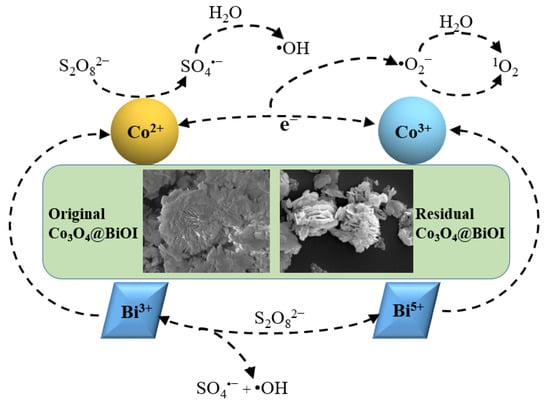
Figure 15.
The possible mechanisms of BPAF degradation in the Co3O4@BiOI/PS system.
The Co(Ⅱ)/Co(Ⅲ) and Bi(Ⅲ)/Bi(V) redox couples combine in a synergism that promotes the activation of PS. In addition, surface lattice oxygen plays a key role in BPAF removal. The major active species (SO4•−, •OH, O2•−, and 1O2) generated during the reaction play synchronous and synergistic roles in converting BPAF to small molecules. The SO4•−, •OH, and O2•− contribute directly to the oxidation process, while 1O2 serves as an intermediate in a mass transfer that facilitates catalytic oxidation.
Co2+ + H2O → CoOH+ + H+
CoOH+ + S2O82− → CoO+ + SO4•− + SO42− + H+
SO4•− + H2O → HSO4− + •OH
CoO+ + H2O + S2O82− → Co2+ + 2 SO42− +•O2− + 2H+
2 •O2− + 2 H2O → H2O2 + 1O2
Bi3+ + S2O82− → Bi5+ + 2SO4•−
Bi5+ + S2O82− + 2 H2O → Bi3+ + 2SO5•− + 4H+
Bi3+ + S2O82− + 2 H2O → Bi5+ + 2 SO42− + 2 •OH
3.5. The Proposed Mechanism in Co3O4@BiOI
We have employed LC-MS analysis to determine the main reaction intermediates and elucidate the BPAF degradation pathway. The TOC concentration in the solution after the reaction was tested to be 1.70 mg/L, and the ratio of mineralization is 66%. A total of 14 intermediates were detected (Table 1). Based on the product distribution and literature reports, three major degradation pathways are proposed, as illustrated in Figure 16. The electron-rich component (benzene ring or p-hydroxyl) of BPAF is attacked by sulfate and hydroxyl generated by PS. The BPAF molecules are converted to phenoxy radicals or the resonance form R1, resulting from a delocalization of unpaired electrons. The β-bonds of benzene rings with a high electron density in the para-position are broken, forming unstable positively charged ions and electronically charged phenol radicals, which are further converted to hydroquinone intermediates (P2 and P3) by hydroxylation and then generate hydroquinone (P4) [39]. The hydroxylated product of BPAF (P5) can undergo ring opening to form P6, a carboxylic acid intermediate, which is converted to P7 by decarbonylation and oxidation and further ring opening and cracking to small molecular products [31]. Hydroxylation of P8 by •OH, a monohydroxylated product of BPAF, generates dihydroxylated P10. In addition, P8 may form P9 by ring opening. The presence of two or more adjacent hydroxyl groups can activate polyhydroxylated products, which are prone to oxidation and formation of quinone intermediates that are converted to P6 by ring opening.

Table 1.
Mass and structures of BPAF and its transformation products by the Co3O4@BiOI/PS system.
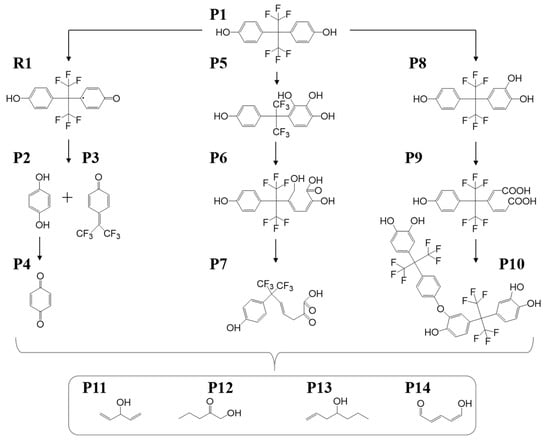
Figure 16.
Possible degradation pathways of BPAF in the Co3O4@BiOI/PS system.
4. Conclusions
In this study, a Co3O4@BiOI composite catalyst was synthesized and used to promote the efficient degradation of BPAF by activating PS. The experimental results have demonstrated a near-complete removal of BPAF within 30 min at a PS dosage of 0.1 mM. BPAF degradation was suppressed under acidic conditions, promoted with the addition of a particular concentration of HCO3− but impeded by Cl−, SO42−, and high concentrations of HCO3−. Moreover, NO3− had a negligible effect on BPAF degradation. A mechanistic analysis has revealed the co-existence of Co(II)/Co(III) and Bi(III)/Bi(V) redox couples that serve to activate PS, involving synergism between the Co3O4 and BiOI components of the composite that facilitate the oxidative degradation of BPAF in water. Three possible BPAF degradation pathways have been identified for the Co3O4@BiOI/PS system.
Author Contributions
Conceptualization, J.Z. and C.L.; methodology, J.Z.; formal analysis, C.L. and Z.L.; investigation, C.L. and Z.L.; resources, J.Z.; data curation, J.Z. and C.L.; writing—original draft preparation, J.Z. and C.L.; writing—review and editing, J.Z. and C.L.; supervision, Q.C.; project administration, J.Z.; funding acquisition, J.Z. All authors have read and agreed to the published version of the manuscript.
Funding
This research was supported by the Chengdu Municipal Science and Technology Bureau (2018-YF09-00041-SN) and Power Construction Corporation of China (DJ-ZDXM-2017-30).
Data Availability Statement
Data are available upon request from the corresponding author.
Conflicts of Interest
All Authors were employed by the company Chengdu Engineering Corporation Ltd., Power China. The Authors Changling Liu have another Affiliations is the State Key Laboratory of Hydraulics and Mountain River Engineering, Sichuan University. All Authors declare that the research was conducted in the absence of any commercial or financial relationships that could be construed as a potential conflict of interest.
References
- Liu, Y.; Lin, Y.; Yen, C.; Miaw, C.; Chen, T.; Wu, M.; Hsieh, C. Identification, contribution, and estrogenic activity of potential EDCs in a river receiving concentrated livestock effluent in Southern Taiwan. Sci. Total Environ. 2018, 636, 464–476. [Google Scholar] [CrossRef] [PubMed]
- Cimmino, I.; Fiory, F.; Perruolo, G.; Miele, C.; Beguinot, F.; Formisano, P.; Oriente, F. Potential Mechanisms of Bisphenol A (BPA) Contributing to Human Disease. Int. J. Mol. Sci. 2020, 21, 5761. [Google Scholar] [CrossRef] [PubMed]
- den Braver-Sewradj, S.P.; van Spronsen, R.; Hessel, E.V.S. Substitution of bisphenol A: A review of the carcinogenicity, reproductive toxicity, and endocrine disruption potential of alternative substances. Crit. Rev. Toxicol. 2020, 50, 128–147. [Google Scholar] [CrossRef] [PubMed]
- Song, S.; Ruan, T.; Wang, T.; Liu, R.; Jiang, G. Distribution and Preliminary Exposure Assessment of Bisphenol AF (BPAF) in Various Environmental Matrices around a Manufacturing Plant in China. Environ. Sci. Technol. 2012, 46, 13136–13143. [Google Scholar] [CrossRef] [PubMed]
- Mu, X.; Huang, Y.; Li, X.; Lei, Y.; Teng, M.; Li, X.; Wang, C.; Li, Y. Developmental Effects and Estrogenicity of Bisphenol A Alternatives in a Zebrafish Embryo Model. Environ. Sci. Technol. 2018, 52, 3222–3231. [Google Scholar] [CrossRef] [PubMed]
- Choi, Y.J.; Lee, L.S. Partitioning Behavior of Bisphenol Alternatives BPS and BPAF Compared to BPA. Environ. Sci. Technol. 2017, 51, 3725–3732. [Google Scholar] [CrossRef]
- Liu, Y.; Zhang, X.; Wu, F. Photodegradation of bisphenol AF in montmorillonite dispersions: Kinetics and mechanism study. Appl. Clay Sci. 2010, 49, 182–186. [Google Scholar] [CrossRef]
- Yang, T.; Wang, L.; Liu, Y.; Huang, Z.; He, H.; Wang, X.; Jiang, J.; Gao, D.; Ma, J. Comparative study on ferrate oxidation of BPS and BPAF: Kinetics, reaction mechanism, and the improvement on their biodegradability. Water Res. 2019, 148, 115–125. [Google Scholar] [CrossRef]
- Wang, Q.; Zeng, H.; Liang, Y.; Cao, Y.; Xiao, Y.; Ma, J. Degradation of bisphenol AF in water by periodate activation with FeS (mackinawite) and the role of sulfur species in the generation of sulfate radicals. Chem. Eng. J. 2021, 407, 126738. [Google Scholar] [CrossRef]
- Li, W.; Zhang, Y.; Cheng, X.; Wang, J.; Yang, B.; Guo, H. Amino-modified metal–organic frameworks as peroxymonosulfate catalyst for bisphenol AF decontamination: ROS generation, degradation pathways, and toxicity evaluation. Sep. Purif. Technol. 2022, 282, 119967. [Google Scholar] [CrossRef]
- Xu, X.; Liu, Q.; Bai, L.; Wang, L.; Wang, D.; Gao, S. Transformation of Bisphenol AF during Aqueous Chlorination: Kinetics, Mechanisms, and Influence of Ph. ACS EST Water 2021, 1, 449–458. [Google Scholar] [CrossRef]
- Khan, J.A.; He, X.; Shah, N.S.; Khan, H.M.; Hapeshi, E.; Fatta-Kassinos, D.; Dionysiou, D.D. Kinetic and mechanism investigation on the photochemical degradation of atrazine with activated H2O2, S2O82− and HSO5−. Chem. Eng. J. 2014, 252, 393–403. [Google Scholar] [CrossRef]
- Kilic, M.Y.; Abdelraheem, W.H.; He, X.; Kestioglu, K.; Dionysiou, D.D. Photochemical treatment of tyrosol, a model phenolic compound present in olive mill wastewater, by hydroxyl and sulfate radical-based advanced oxidation processes (AOPs). J. Hazard. Mater. 2019, 367, 734–742. [Google Scholar] [CrossRef] [PubMed]
- Sajjadi, S.; Khataee, A.; Bagheri, N.; Kobya, M.; Şenocak, A.; Demirbas, E.; Karaoğlu, A.G. Degradation of diazinon pesticide using catalyzed persulfate with Fe3O4@MOF-2 nanocomposite under ultrasound irradiation. J. Ind. Eng. Chem. 2019, 77, 280–290. [Google Scholar] [CrossRef]
- Lei, Y.; Tian, Y.; Fang, C.; Zhan, W.; Duan, L.; Zhang, J.; Zuo, W.; Kong, X. Insights into the oxidation kinetics and mechanism of diesel hydrocarbons by ultrasound activated persulfate in a soil system. Chem. Eng. J. 2019, 378, 122253. [Google Scholar] [CrossRef]
- Bruton, T.A.; Sedlak, D.L. Treatment of perfluoroalkyl acids by heat-activated persulfate under conditions representative of in situ chemical oxidation. Chemosphere 2018, 206, 457–464. [Google Scholar] [CrossRef]
- Yang, L.; Xue, J.; He, L.; Wu, L.; Ma, Y.; Chen, H.; Li, H.; Peng, P.; Zhang, Z. Review on ultrasound assisted persulfate degradation of organic contaminants in wastewater: Influences, mechanisms and prospective. Chem. Eng. J. 2019, 378, 122146. [Google Scholar] [CrossRef]
- Guo, H.; Ke, T.; Gao, N.; Liu, Y.; Cheng, X. Enhanced degradation of aqueous norfloxacin and enrofloxacin by UV-activated persulfate: Kinetics, pathways and deactivation. Chem. Eng. J. 2017, 316, 471–480. [Google Scholar] [CrossRef]
- Huang, Y.; Sun, Y.; Xu, Z.; Luo, M.; Zhu, C.; Li, L. Removal of aqueous oxalic acid by heterogeneous catalytic ozonation with MnOx/sewage sludge-derived activated carbon as catalysts. Sci. Total Environ. 2017, 575, 50–57. [Google Scholar] [CrossRef]
- Qian, L.; Kopinke, F.; Scherzer, T.; Griebel, J.; Georgi, A. Enhanced degradation of perfluorooctanoic acid by heat-activated persulfate in the presence of zeolites. Chem. Eng. J. 2022, 429, 132500. [Google Scholar] [CrossRef]
- Li, Y.; Sun, J.; Sun, S.P. Mn2+-mediated homogeneous Fenton-like reaction of Fe(III)-NTA complex for efficient degradation of organic contaminants under neutral conditions. J. Hazard. Mater. 2016, 313, 193–200. [Google Scholar] [CrossRef] [PubMed]
- Yang, W.; Li, X.; Jiang, Z.; Li, C.; Zhao, J.; Wang, H.; Liao, Q. Structure-dependent catalysis of Co3O4 crystals in persulfate activation via nonradical pathway. Appl. Surf. Sci. 2020, 525, 146482. [Google Scholar] [CrossRef]
- Avetta, P.; Pensato, A.; Minella, M.; Malandrino, M.; Maurino, V.; Minero, C.; Hanna, K.; Vione, D. Activation of Persulfate by Irradiated Magnetite: Implications for the Degradation of Phenol under Heterogeneous Photo-Fenton-Like Conditions. Environ. Sci. Technol. 2015, 49, 1043–1050. [Google Scholar] [CrossRef]
- Zhang, J.; Chen, M.; Zhu, L. Activation of persulfate by Co3O4 nanoparticles for orange G degradation. RSC Adv. 2016, 6, 758–768. [Google Scholar] [CrossRef]
- Wang, S.; Wang, J. Bimetallic and nitrogen Co-doped biochar for peroxymonosulfate (PMS) activation to degrade emerging contaminants. Sep. Purif. Technol. 2023, 307, 122807. [Google Scholar] [CrossRef]
- Jiang, Z.; Li, Y.; Zhou, Y.; Liu, X.; Wang, C.; Lan, Y.; Li, Y. Co3O4-MnO2 nanoparticles moored on biochar as a catalyst for activation of peroxymonosulfate to efficiently degrade sulfonamide antibiotics. Sep. Purif. Technol. 2022, 281, 119935. [Google Scholar] [CrossRef]
- Chen, X.; Li, F.; Zhang, M.; Liu, B.; Chen, H.; Wang, H. Highly dispersed and stabilized Co3O4/C anchored on porous biochar for bisphenol A degradation by sulfate radical advanced oxidation process. Sci. Total Environ. 2021, 777, 145794. [Google Scholar] [CrossRef] [PubMed]
- Su, Y.; Zheng, X.; Cheng, H.; Rao, M.; Chen, K.; Xia, J.; Lin, L.; Zhu, H. Mn-Fe3O4 nanoparticles anchored on the urushiol functionalized 3D-graphene for the electrochemical detection of 4-nitrophenol. J. Hazard. Mater. 2021, 409, 124926. [Google Scholar] [CrossRef]
- Li, X.; Niu, C.; Huang, D.; Wang, X.; Zhang, X.; Zeng, G.; Niu, Q. Preparation of magnetically separable Fe3O4/BiOI nanocomposites and its visible photocatalytic activity. Appl. Surf. Sci. 2013, 286, 40–46. [Google Scholar] [CrossRef]
- Bao, S.; Yan, N.; Shi, X.; Li, R.; Chen, Q. High and stable catalytic activity of porous Ag/Co3O4 nanocomposites derived from MOFs for CO oxidation. Appl. Catal. A Gen. 2014, 487, 189–194. [Google Scholar] [CrossRef]
- Qin, C.; Qi, Y.; Teng, X.; Ajarem, J.S.; Allam, A.A.; Qu, R. Degradation of Bisphonel AF (BPAF) by zero-valent iron activated persulfate: Kinetics, mechanisms, theoretical calculations, and effect of co-existing chloride. Chemosphere 2023, 316, 137774. [Google Scholar] [CrossRef]
- Chen, W.; Huang, J.; Yu, X.; Fu, X.; Zhu, Y.; Zhang, Y. The roles of graphene and sandwich structure in rGO/BiOI/rGO to enhance the photoelectrocatalytic activity. J. Solid State Chem. 2020, 289, 121480. [Google Scholar] [CrossRef]
- Xiong, J.; Zeng, H.; Xu, S.; Peng, J.; Liu, F.; Wang, L. Enhancing the intrinsic properties of flower-like BiOI by S-doping toward excellent photocatalytic performances. J. Mater. Sci. Technol. 2022, 118, 181–189. [Google Scholar] [CrossRef]
- Tang, W.; Zhang, Y.; Guo, H.; Liu, Y. Heterogeneous activation of peroxymonosulfate for bisphenol AF degradation with BiOI0.5Cl0.5. RSC Adv. 2019, 9, 14060–14071. [Google Scholar] [CrossRef] [PubMed]
- Malefane, M.E.; Feleni, U.; Mafa, P.J.; Kuvarega, A.T. Fabrication of direct Z-scheme Co3O4/BiOI for ibuprofen and trimethoprim degradation under visible light irradiation. Appl. Surf. Sci. 2020, 514, 145940. [Google Scholar] [CrossRef]
- Song, Y.; Qi, J.; Tian, J.; Gao, S.; Cui, F. Construction of Ag/g-C3N4 photocatalysts with visible-light photocatalytic activity for sulfamethoxazole degradation. Chem. Eng. J. 2018, 341, 547–555. [Google Scholar] [CrossRef]
- Liang, C.; Wang, Z.; Mohanty, N. Influences of carbonate and chloride ions on persulfate oxidation of trichloroethylene at 20 °C. Sci. Total Environ. 2006, 370, 271–277. [Google Scholar] [CrossRef]
- Wu, C.; Linden, K.G. Phototransformation of selected organophosphorus pesticides: Roles of hydroxyl and carbonate radicals. Water Res. 2010, 44, 3585–3594. [Google Scholar] [CrossRef] [PubMed]
- Wang, Q.; Cao, Y.; Zeng, H.; Liang, Y.; Ma, J.; Lu, X. Ultrasound-enhanced zero-valent copper activation of persulfate for the degradation of bisphenol AF. Chem. Eng. J. 2019, 378, 122143. [Google Scholar] [CrossRef]
- Wang, Z.; Wang, Z.; Li, W.; Lan, Y.; Chen, C. Performance comparison and mechanism investigation of Co3O4-modified different crystallographic MnO2 (α, β, γ, and δ) as an activator of peroxymonosulfate (PMS) for sulfisoxazole degradation. Chem. Eng. J. 2022, 427, 130888. [Google Scholar] [CrossRef]
- Quang, N.D.; Majumder, S.; Van, P.C.; Jeong, J.; Kim, C.; Kim, D. Co3O4/reduced graphene oxide/BiVO4 nanorod as high performance photoanode for water oxidation. Electrochim. Acta 2020, 364, 137283. [Google Scholar] [CrossRef]
- Ren, Y.; Lin, L.; Ma, J.; Yang, J.; Feng, J.; Fan, Z. Sulfate radicals induced from peroxymonosulfate by magnetic ferrospinel MFe2O4 (M = Co, Cu, Mn, and Zn) as heterogeneous catalysts in the water. Appl. Catal. B Environ. 2015, 165, 572–578. [Google Scholar] [CrossRef]
- Yang, Q.; Choi, H.; Dionysiou, D.D. Nanocrystalline cobalt oxide immobilized on titanium dioxide nanoparticles for the heterogeneous activation of peroxymonosulfate. Appl. Catal. B Environ. 2007, 74, 170–178. [Google Scholar] [CrossRef]
- Zhang, L.; Yang, X.; Han, E.; Zhao, L.; Lian, J. Reduced graphene oxide wrapped Fe3O4–Co3O4 yolk–shell nanostructures for advanced catalytic oxidation based on sulfate radicals. Appl. Surf. Sci. 2017, 396, 945–954. [Google Scholar] [CrossRef]
- Anipsitakis, G.P.; Dionysiou, D.D. Radical Generation by the Interaction of Transition Metals with Common Oxidants. Environ. Sci. Technol. 2004, 38, 3705–3712. [Google Scholar] [CrossRef]
- Wang, Y.; Indrawirawan, S.; Duan, X.; Sun, H.; Ang, H.M.; Tadé, M.O.; Wang, S. New insights into heterogeneous generation and evolution processes of sulfate radicals for phenol degradation over one-dimensional α-MnO2 nanostructures. Chem. Eng. J. 2015, 266, 12–20. [Google Scholar] [CrossRef]
- Li, X.; Liu, J.; Rykov, A.I.; Han, H.; Jin, C.; Liu, X.; Wang, J. Excellent photo-Fenton catalysts of Fe–Co Prussian blue analogues and their reaction mechanism study. Appl. Catal. B Environ. 2015, 179, 196–205. [Google Scholar] [CrossRef]
Disclaimer/Publisher’s Note: The statements, opinions and data contained in all publications are solely those of the individual author(s) and contributor(s) and not of MDPI and/or the editor(s). MDPI and/or the editor(s) disclaim responsibility for any injury to people or property resulting from any ideas, methods, instructions or products referred to in the content. |
© 2024 by the authors. Licensee MDPI, Basel, Switzerland. This article is an open access article distributed under the terms and conditions of the Creative Commons Attribution (CC BY) license (https://creativecommons.org/licenses/by/4.0/).









